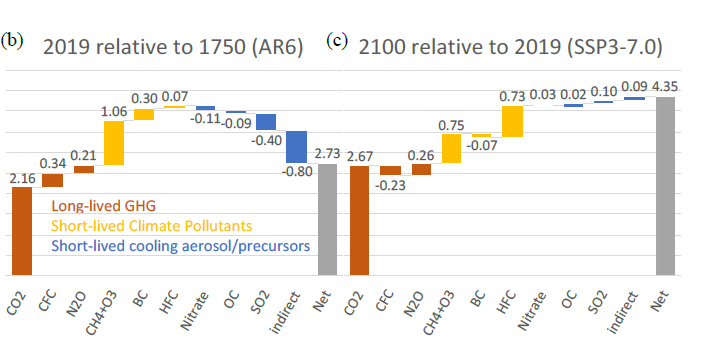Contribution of short-lived climate pollutants to global warming
The US NOAA Annual Greenhouse Gas Index (AGGI) provides a simple accessible analysis of the contribution of a range of GHGs to global warming (see previous item). A more detailed recent study ‘Mitigating climate disruption in time: A self-consistent approach for avoiding both near-term and long-term global warming’ looks at the implications of controlling long-lived gases (CO2) and short-lived climate pollutants (SLCPs) in the drive to minimise the increase in global warming. SLCPs are black carbon, methane, tropospheric ozone, and hydrofluorocarbons (HFCs). This study clarifies the need for comprehensive CO2 and non-CO2 mitigation approaches to address both near-term (before 2050) and long-term warming (after 2050).
In 2019, contributions to radiative forcing from emissions by non- fossil fuel non-CO2 GHGs was about 45%, with fossil fuel CO2 and black carbon accounting for 55%. The non-CO2 GHG is dominated by methane emissions which account for nearly half of the non-CO2 contribution, with HFCs accounting for 4% of the non-CO2 forcing. This is consistent with the NOAA AGGI.
One of the baseline scenarios projects about a ten-times increase in the contribution of HFC emissions to radiative forcing at 2100 compared to 2019 (see Figure). “The changes in the projection through 2100 under the limited climate policy SSP3-7.0 scenario [see explanation below] show that by 2100, around 70% of net forcing relative to 2019 is due to Fossil Fuel and other CO2 emissions, emphasizing the importance of adopting decarbonization together with strategies targeting non-CO2 to address near-term and long-term warming.” The study discusses a range of mitigation options for SLCPs, including pairing decarbonization with additional mitigation measures targeting short-lived climate pollutants and N2O (not an SLCP due to its longer lifetime).
Figure S5 from paper supplementary information: The radiative forcing at 2019 relative to 1750 (AR6) and 2100 relative to 2019, under SSP3-7.0 emissions (limited climate policy scenario).

In its conclusions the study states that adopting a comprehensive mitigation approach that pairs rapid decarbonisation with “strong, rapid and sustained reductions in CH4 emissions” as recommended in the Global Methane Assessment and additional targeted SLCP mitigation responds to the call from IPCC WGII (Impacts, Adaptation and Vulnerability) for urgent action to slow warming in the near term.
Explanatory Notes
GWP20, GWP100 and other emission metrics: This paper also discusses the use of GWP20, GWP100 and other emission metrics in the context of slowing warming in the near term. For more detailed information about emission metrics, IPCC AR6 discusses their use, including GWP-20 and GWP-100 and how they perform. A summary is available in IPCC AR6 DISCUSSES THE USE OF 100-YEAR AND 20-YEAR GWPS AND OTHER EMISSION METRICS - Fluorocarbons. For more detailed information see IPCC AR6 - Climate Change 2021, The Physical Science Basis - Chapter 7.
Kigali Amendment: According to IPCC AR6 Climate Change: The Physical Science Basis. Assuming implementation and efficient enforcement of both the Kigali Amendment to the Montreal Protocol on Ozone Depleting Substances and current national plans limit emissions, the effects of HFCs on global mean near-surface air temperature (GSAT), relative to 2019, would remain below +0. 02°C from 2050 onwards versus about +0.04–0.08°C in 2050 and +0.1–0.3°C in 2100 considering only national HFC regulations decided prior to the Kigali Amendment. Further improvements in the efficiency of refrigeration and air-conditioning equipment during the transition to low-global-warming potential refrigerants would bring additional GHG reductions resulting in benefits for climate change mitigation and to a lesser extent for air quality due to reduced air pollutant emissions from power plants.
SSP3-7.0 scenario: The IPCC AR6 Climate Change: The Physical Science Basis SSP3-7.0 pathway is considered by many experts to be a realistic worst-case scenario, with global carbon emissions continuing to rise every year throughout the 21st century. Such an outcome would represent a complete failure of international climate negotiations and policies and would likely result in catastrophic consequences, including widespread species extinctions, food and water shortages, and disastrous extreme weather events. Summary from Yale Climate Connections.
Reference:
Mitigating climate disruption in time: A self-consistent approach for avoiding both near-term and long-term global warming, G. B. Dreyfus, Y. Xuc, D. T. Shindell, D. Zaelkea, and V. Ramanathan, PNAS 2022 Vol. 119 No. 22 e2123536119 https://www.pnas.org/doi/full/10.1073/pnas.2123536119